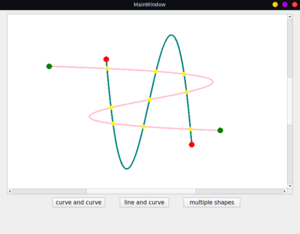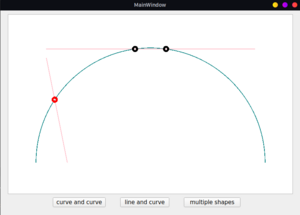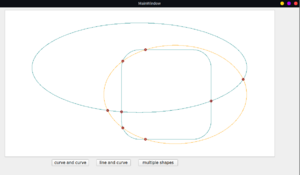GSoC/2021/StatusReports/TanmayChavan: Difference between revisions
| Line 30: | Line 30: | ||
* Relevant links: | * Relevant links: | ||
** | ** Phabricator task: https://phabricator.kde.org/T14679 | ||
** Relevant MRs: https://invent.kde.org/earendil/bezierintersections (''Due to the nature of the project, the code can only be merged with Krita codebase upon the entire task being done. Because of this, I have added my work in a seperate toy Qt project which also provides a simple graphic view of the progress until now.'')<br> | ** Relevant MRs: https://invent.kde.org/earendil/bezierintersections (''Due to the nature of the project, the code can only be merged with Krita codebase upon the entire task being done. Because of this, I have added my work in a seperate toy Qt project which also provides a simple graphic view of the progress until now.'') | ||
** Blog post: https://tanmay-chavan.github.io/jasper-blog/jekyll/update/2021/07/13/gsoc-update.html<br> | |||
=== Qt private dependencies === | === Qt private dependencies === | ||
Revision as of 08:00, 14 July 2021
Krita - Smarter boolean operations on vector shapes
In Krita, performing boolean operations on vector shapes leads to a large number of unnecessary nodes. This happens because Qt lacks a proper algorithm to find the intersection point of two Bezier curves. I plan on implementing a numerically stable as well as efficient algorithm to find the intersections of two Bezier curves.
Mentors
- Dmitry Kazakov
- Iván Santa María
Goals
- Create a new algorithm to compute intersections of Bezier curves using implicitization
- done!
- Manage the dependencies and implement parts of Qt private modules in Krita codebase
- done!
- Integrate the algorithm with current intersection finding routine
- done!
- Implement the new routine for boolean operations
- pending
- Write proper documentation and unit tests for all the above goals while doing them
- ongoing
Status Report
Algorithm for Bezier curve intersection
- This was the exact feature which Qt lacked for boolean operations. As a result, it flattened the curves which in turn made too many nodes. I have implemented an algorithm to compute the intersection points using the implicit representation of a cubic Bezier curve. I have finished implementing curve-curve, line-curve intersections by now. The algorithm works well even with double precision. But, the curve-curve intersections can get really costly. On an average, a single curve-curve intersection-finding routine requires ~280 microseconds. However, it is reported this is the fastest method for curves with degree 5 or less. The line-line intersection point is obtained in the same manner as Qt did.


- Relevant links:
- Phabricator task: https://phabricator.kde.org/T14679
- Relevant MRs: https://invent.kde.org/earendil/bezierintersections (Due to the nature of the project, the code can only be merged with Krita codebase upon the entire task being done. Because of this, I have added my work in a seperate toy Qt project which also provides a simple graphic view of the progress until now.)
- Blog post: https://tanmay-chavan.github.io/jasper-blog/jekyll/update/2021/07/13/gsoc-update.html
Qt private dependencies
- As the set operations were handled by the class QPathClipper which lies behind the Qt API, I had to manage the dependencies so that the new implementation would not rely on Qt private modules. This was relatively easy as QPathClipper was fairly independent and it's dependencies didn't have too many dependencies. I also managed to get a downstream copy of the QPainterPath class, albeit had to skip some parts (the PathStroker related part) as it was too closely linked to other Qt private modules. However, it was not required for the purpose of the current tasks. So, I have managed to get the project to run without any private or additional dependencies.
- Relevant links:
- Relevant MRs: https://invent.kde.org/earendil/bezierintersections
- Relevant MRs: https://invent.kde.org/earendil/bezierintersections
Intersection finding routine
- For this, I am using a downstream copy of QPainterPath. The elements of QPainterPaths are extracted and stored in the local version of PainterPath. After this, two vectors for subject shape and clip shape are created, where elements are added with the classes CubicBezier or Line as per the type of elements. Then, it proceeds to find the intersection points between the elements of the two vectors. These are stored in a separate class member with some additional information which could be helpful to perform set operations.

- Relevant links:
- phabricator task: https://phabricator.kde.org/T14681
- Relevant MRs: https://invent.kde.org/earendil/bezierintersections
Links
- Blog: https://tanmay-chavan.github.io/jasper-blog/
- Project repo: https://invent.kde.org/earendil/bezierintersections (master branch)
- Phabricator task: https://phabricator.kde.org/T14574
Current task
I'm currently working on the clipping algorithm. For that, some preprocessing is required for any of the two approaches. I will be able to provide a working demo (although an unoptimized one) in a few days.
